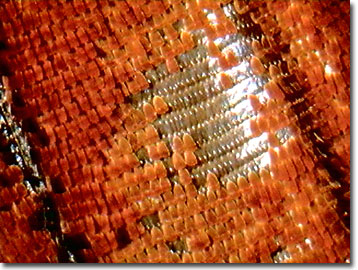Butterfly Wing Scale Digital Image Gallery
Rusty-Tipped Page Butterfly
Although rusty-tipped page butterflies sport hind wing extensions similar to those of swallowtails, they are placed in the brush-footed butterfly family, Nymphalidae. Their highly modified first pair of legs is used for sensing suitable host plants by taste, rather than for walking. Unlike many rainforest butterflies, which spend most of their time feeding and flying at the canopy level, the rusty-tipped page often flies back and forth across edge vegetation at less than 2 meters from the ground.

Rarely straying as far north as the United States, the rusty-tipped page butterfly, also known as Siproeta epaphus, is native to tropical forests and riparian corridors from south Peru through Mexico. Ranging between 400 and 1,500 meters in elevation, these lepidopterans prefer mountain slopes with wet forest habitat. Their favored environment lacks a pronounced dry season and corresponds to the conditions conducive to growing coffee. Similar to many humans, these butterflies start their day off with a bit of java. Members of the species sip nectar from the plants in the morning and can be viewed for hours fluttering between coffee shrubs.
Aptly named for its rust colored wingtips, the rusty-tipped page butterfly flashes a warning coloration of black and orange to potential predators. However, not all predators heed the admonition and bird-beak tears are often found in the wings of wild specimen. Adults are sometimes known as brown bamboo page or brown siproeta butterflies based on the colors of their more subdued wing undersides. In addition to coffee plants, adults gain moisture and nutrition from the flower nectar of croton, lantana, and impatiens. Male rusty-tipped pages also sip moisture and minerals from wet sand and often are observed at river crossings.
The other life stages of the rusty-tipped page are just as colorful and important as the adult. Groups of dark green eggs with yellow ribs are laid on young shrimp plants and petunias. When conditions are right, the eggs hatch and the caterpillars that emerge are eye-catching. The larvae are a velvety maroon with bright yellow-orange spikes and a shiny black head that holds a pair of knobbed horns. As Batesian mimics, the edible caterpillars imitate the distasteful larvae of swallowtails in the genera Battus and Parides. After significant feasting and growth, the larvae pupate. The cryptic chrysalis formed by a rusty-tipped page is pale green, pointed, and hangs down from a silken thread by its posterior cremaster. A new butterfly slowly emerges from its pupal case to begin a new generation when metamorphosis is complete.
Contributing Authors
Cynthia D. Kelly, Shannon H. Neaves, Laurence D. Zuckerman, and Michael W. Davidson - National High Magnetic Field Laboratory, 1800 East Paul Dirac Dr., The Florida State University, Tallahassee, Florida, 32310.
BACK TO THE BUTTERFLY WING SCALE IMAGE GALLERY
BACK TO THE DIGITAL IMAGE GALLERIES
Questions or comments? Send us an email.
© 1995-2025 by Michael W. Davidson and The Florida State University. All Rights Reserved. No images, graphics, software, scripts, or applets may be reproduced or used in any manner without permission from the copyright holders. Use of this website means you agree to all of the Legal Terms and Conditions set forth by the owners.
This website is maintained by our
Graphics & Web Programming Team
in collaboration with Optical Microscopy at the
National High Magnetic Field Laboratory.
Last Modification Friday, Nov 13, 2015 at 01:19 PM
Access Count Since January 21, 2003: 9144
Visit the website of our partner in introductory microscopy education:
|
|
